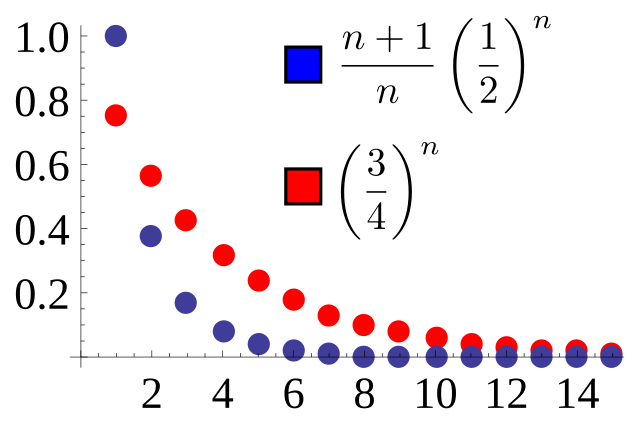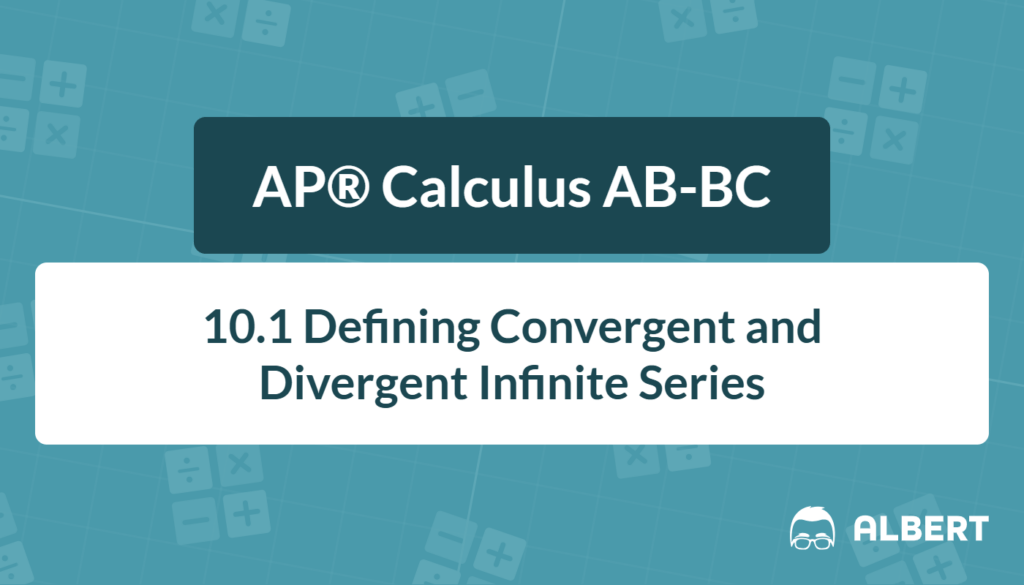Infinite series play an important role in AP® Calculus AB-BC and beyond. These sums of infinitely many terms reveal behaviors that help solve real-world problems, like computing areas and modeling natural phenomena. Understanding infinite series convergence and divergence provides essential insight into whether an infinite sum has a finite value or grows without bound. Moreover, series build on the concept of sequences, since adding sequence terms is the foundation of a series.
What We Review
Sequence vs. Series
Defining a Sequence
A sequence is an ordered list of numbers. One way to represent it is a_n, where the subscript n indicates the term’s position in the list. For example, a simple sequence might be the integers starting from 1 and increasing by 1 each time.
Example 1: Simple Sequence Formation
Consider the sequence a_n = n. Here:
- The first term is a_1 = 1.
- The second term is a_2 = 2.
- The third term is a_3 = 3, and so on.
To form a series from this sequence, sum the terms. The corresponding series becomes 1 + 2 + 3 + \dots.
Two more examples of sequences are shown in the graph below.

Practice Problem:
Form a series using the sequence a_n = 2n. Write the first four terms of the sequence and then write the first four terms of the series.
Solution to Practice Problem:
- Sequence terms: a_1=2, a_2=4, a_3=6, a_4=8.
- Series up to four terms: 2 + 4 + 6 + 8.
Defining a Series
A series is the sum of terms from a sequence. Look at the sequence a_n and create S = a_1 + a_2 + a_3 + \dots. Adding more terms leads to partial sums, which show whether the series converges to a finite number or diverges.
Partial Sums and Convergence: Understanding Infinite Series Convergence and Divergence
Partial Sums
A partial sum is the sum of the first n terms of a series. It is often written as S_n, where S_n = a_1 + a_2 + \dots + a_n.If S_n settles to a specific value when n grows very large, the series converges.
Criteria for Convergence
A series \sum a_n converges if its partial sums approach a finite limit S. Formally, if\lim_{n \to \infty} S_n = S,then the infinite series converges to S. If that limit does not exist or grows without bound, the series diverges.
Example 2: Convergent Geometric Series
Consider the geometric series
\sum_{n=0}^{\infty} \left(\frac{1}{2}\right)^n = 1 + \frac{1}{2} + \frac{1}{4} + \frac{1}{8} + \dotsStep-by-Step Solution:
- Identify the first term a = 1 and the common ratio r = \tfrac{1}{2}.
- The nth partial sum is S_n = a \frac{1 - r^n}{1 - r} = 1 \cdot \frac{1 - \left(\frac{1}{2}\right)^n}{1 - \frac{1}{2}}.
- Simplify the formula: S_n = \frac{1 - \left(\frac{1}{2}\right)^n}{\frac{1}{2}} = 2 \left(1 - \left(\frac{1}{2}\right)^n\right).
- Take the limit as n \to \infty: \lim_{n \to \infty} S_n = 2 \left(1 - 0\right) = 2.
- Conclude that the infinite series converges to 2.
Practice Problem:
Determine the sum of the infinite geometric series
\sum_{n=0}^{\infty} \left(\frac{1}{3}\right)^n.Solution to Practice Problem:
- Identify the first term a=1 and common ratio r=\tfrac{1}{3}.
- Use the geometric sum formula: S = \frac{a}{1 - r} = \frac{1}{1 - \frac{1}{3}} = \frac{1}{\frac{2}{3}} = \frac{3}{2}.
When Does an Infinite Series Diverge?
A series diverges when its partial sums fail to settle on a single finite value. For instance, the series 1 + 1 + 1 + \dots grows larger forever, so it does not converge. Another example is 1 - 1 + 1 - 1 + \dots, where the sum oscillates and does not land on one limit. Therefore, an infinite series diverges if the limit of partial sums does not exist or goes to infinity.
How to Find the Sum of a Series
Common Techniques
There are several ways to find the sum of a series if it converges:
- Use the geometric series formula if there is a common ratio.
- Identify telescoping series, where many terms cancel each other out.
- Apply advanced tools from calculus for more complex series (beyond the scope here).
Example 3: Telescoping Series
A telescoping series is one where consecutive terms cancel out, leaving a simple expression.
Consider:
\sum_{n=1}^{\infty} \left(\frac{1}{n} - \frac{1}{n+1}\right).Step-by-Step Solution:
- Write the first few partial sums:
- S_1 = \left(\frac{1}{1} - \frac{1}{2}\right), S_2 = \left(\frac{1}{1} - \frac{1}{2}\right) + \left(\frac{1}{2} - \frac{1}{3}\right) = 1 - \frac{1}{3}, S_3 = 1 - \frac{1}{4}, and so on.
- Notice that most terms cancel out. In general, S_n = 1 - \frac{1}{n+1}.
- Evaluate the limit: \lim_{n \to \infty} \left(1 - \frac{1}{n+1}\right) = 1.
- Conclude that the series converges to 1.
Practice Problem:
Find the sum of the series
\sum_{n=1}^{\infty} \left(\frac{1}{n} - \frac{1}{n+2}\right).Solution to Practice Problem:
- Write out the first few partial sums to observe cancellation.
- The partial sum S_n becomes 1 + \frac{1}{2} - \frac{1}{n+1} - \frac{1}{n+2}.
- The limit as n \to \infty is 1 + \frac{1}{2} = \frac{3}{2}.
Summary and Key Takeaways
It is essential to distinguish a sequence (a_n) from a series (sum of a_n) to analyze infinite series convergence and divergence. Partial sums S_n help determine whether a series converges by revealing its limiting behavior. If partial sums approach a fixed value, the series converges. Otherwise, the series diverges. Furthermore, knowing how to find the sum of a series can involve geometric formulas or identifying telescoping series when terms collapse neatly.
Quick Reference Chart: Important Vocabulary
| Term | Definition |
| Sequence | An ordered list of numbers, typically expressed as a_n. |
| Series | The sum of the terms of a sequence, written as \sum a_n. |
| Partial Sum | The sum of the first n terms of a series, S_n. |
| Convergent Series | A series whose partial sums approach a finite limit. |
| Divergent Series | A series whose partial sums do not settle to a finite limit. |
| Telescoping Series | A series in which many terms cancel out in the partial sums. |
Conclusion
Infinite series convergence and divergence provide a window into whether an infinitely long sum arrives at a finite value. Identifying convergence involves checking if partial sums approach a limit. When a limit does not exist, the series diverges. Exploring how to find the sum of a series reveals that geometric and telescoping series offer straightforward ways to calculate that sum. These ideas are fundamental to deeper studies in calculus, where infinite series help solve integrals, approximate functions, and tackle advanced problems in AP® Calculus AB-BC.
Sharpen Your Skills for AP® Calculus AB-BC
Are you preparing for the AP® Calculus exam? We’ve got you covered! Try our review articles designed to help you confidently tackle real-world math problems. You’ll find everything you need to succeed, from quick tips to detailed strategies. Start exploring now!
Need help preparing for your AP® Calculus AB-BC exam?
Albert has hundreds of AP® Calculus AB-BC practice questions, free responses, and an AP® Calculus AB-BC practice test to try out.








